There are lots of different health problems that hamsters can suffer from, but here we’ve collated some of the most common issues that it’s a good idea to look out for. If your hamster appears to be in pain, is having trouble breathing or is bleeding, we strongly advise you take your pet to a small mammal vet as soon as possible.
Cuts And Scrapes
Like us, hamsters can get little cuts and scrapes through their day-to-day life. If you notice that your hamster has a little cut, try to figure out where this is has come from, so that you can remove the danger and minimise the risk of your hamster cutting itself again. If it’s just a little cut, then you can put a bit of lukewarm water on a ball of cotton wool and dab at the cut very gently to clean it. We don’t advise using anything intended to help human cuts heal, like bandages, antiseptics or creams. If the wound is large, deep or will not stop bleeding, then the hamster needs to see a vet.
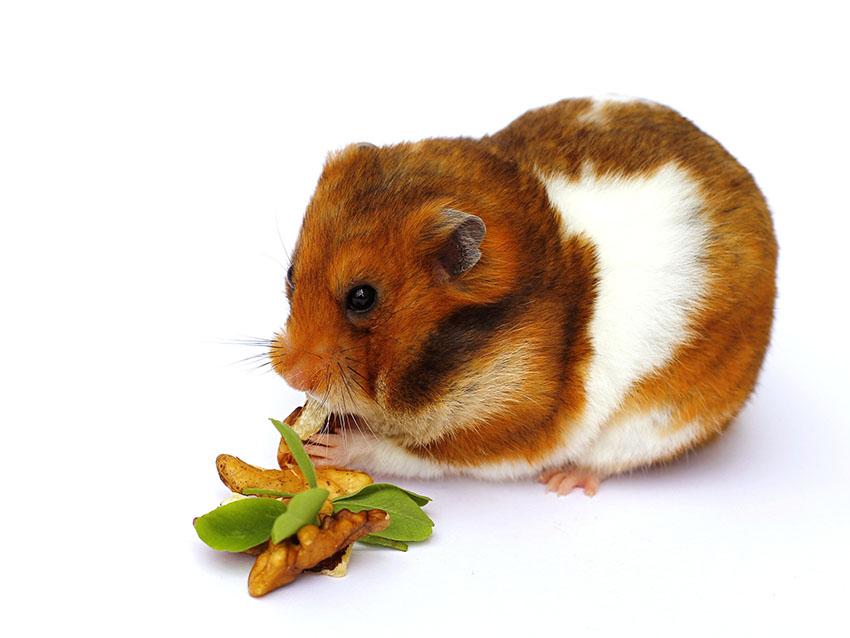
Making sure your pet has all the vitamins and minerals it needs will help it ward off infections
Hamsters can develop infections, and sometimes this can cause an abscess to form. Abscesses can form on any area of the body (even in the mouth), and are a result of infection, usually by Streptococcus or Staphylococcus bacteria. Abscesses can be very painful for your hamster, and they will need draining and cleansing by a vet, so we advise seeking advice from a small mammal veterinarian or a veterinary nurse.
The main symptom of an abscess is the development of a swelling on the body, one which may be soft or hard - this swelling is full of pus that the hamster’s body has produced during its fight with the infection.
Bar Rub
If your hamster cage has bars, then you might notice that your hamster spends a lot of time gnawing at them. This behaviour, if done a lot, can result in hair loss and bleeding, and perhaps even permanent scarring due to friction.
Causes of Bar Rub include:
- Needing to chew
Bar Rub might be a sign that your hamster needs a chew in its enclosure. Hamster’s teeth grow throughout their lives, and those in captivity often lack the right food or materials needed to keep their teeth at a comfortable length. Your hamster may be resorting to bar-chewing as it has no other way of keeping its teeth a good size. You might want to give it something softer to chew, such as a hamster chew or gnaw.
- Boredom
Another potential cause is that your hamster needs more stimulation. It might like to leave its cage and enjoy some more time with you, or some different activities. Increasing the amount of time you spend playing with your pet may be the answer, but there are more stimulating toys that you can offer your pet.
- A need for exercise
Does your hamster have a large enough enclosure, and a correctly-sized wheel that it has constant access to? Purchasing one and fixing it securely to the cage will help provide your pet with the exercise it needs. If your hamster wheel is too small, then your hamster may neglect it, as it won’t fit inside it properly - adult Syrian hamsters require a wheel that is at least twenty centimeters wide./p>
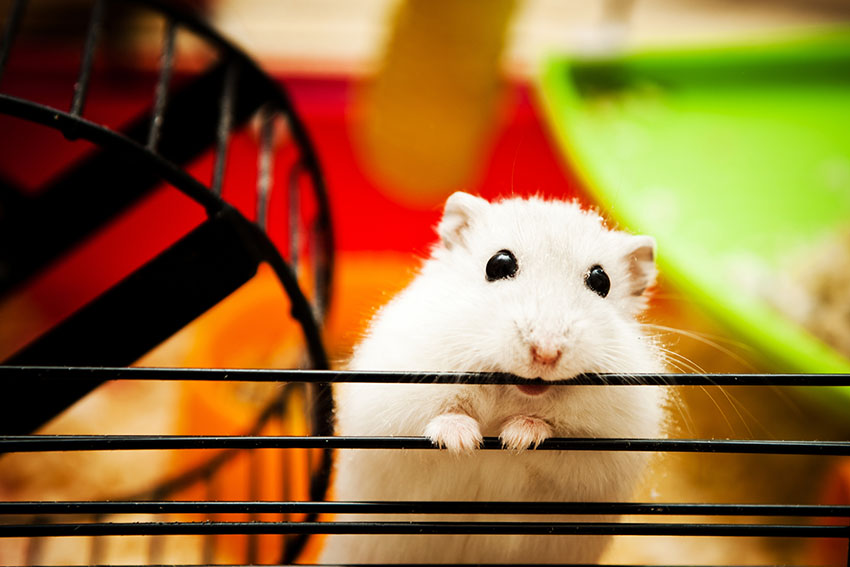
Bar rub can be a very painful condition
Circling
If your hamster moves in circles, running round seemingly without cause, then this could be a behaviour known as ‘circling’ or ‘twirling’ and could indicate that there’s something wrong with your pet. There are a number of different causes, but perhaps one of the most common is also one of the most treatable - an ear infection. If a vet is able to diagnose this condition then they can prescribe a medicine which should provide your pet with some relief, and they’ll stop circling quite quickly.
It’s always best to get this condition checked by a vet, as it may not be an ear infection but something more serious, such as brain damage. If you notice your pet circling, it’s best to take your pet to the vet.
Coughs and Colds
Hamsters can catch colds just as we can, and these illnesses can even be passed from human to hamster. If you’re not very well, or if a member of your household isn’t very well, then it’s a good idea to keep you (or them) away from your pet for a little while until the illness has passed. It also may be best to keep the ill pet away from any other hamsters you have for a little while.
Symptoms of coughs and colds are similar to those that you’d expect with a human: difficulty breathing, sneezing, coughing, and a wet nose. We advise that you take them to a vet - the symptoms of a cold may actually mean that your hamster has an infection or allergy.
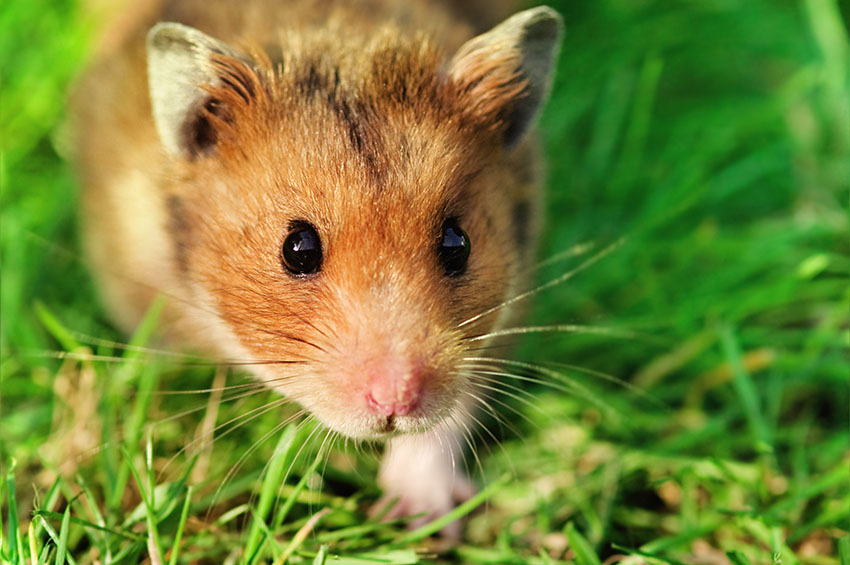
Hamsters can catch coughs and colds, too
If you notice that the skin on your hamster’s ears is flaky, then you may also notice that your hamster is scratching them a lot. If this is the case, then you can alleviate the problem with a little bit of petroleum jelly. Smoothing a tiny bit of this on your pet’s ears will help the symptoms for a while, but you might want to start building this treatment into your regular care routine.
Dehydration
If your hamster is lying down and not moving, and possibly hyperventilating too, then your pet could be suffering from dehydration. Get your hamster out of the heat as quickly as possible, and smooth a bit of cool, but not icy, water onto them to try to cool them. It’s a good idea to put a little saucer of water in their cage temporarily, encouraging them to drink as much as possible. Many people underestimate how hot hamster cages can get, particularly those made of glass or plastic. We strongly suggest keeping your pet’s enclosure out of direct sunlight.
Hamsters can become dehydrated even if their water bottle is full. In high temperatures, hamsters can overheat and become dehydrated, sometimes life-threateningly so. They might not be able to drink enough to keep their temperature down.
To prevent dehydration, it’s also a very good idea to keep a close eye on your pet’s water bottle, as these water dispensers are capable of developing blockages. If you touch the tip of your pet’s bottle when it’s attached in its usual position in the cage, then your finger should come away wet. If it comes away dry, then there is a blockage, and the bottle will need to be fixed or replaced as soon as possible. In the meantime, as we mentioned above, offer your pet an alternative water-source, one that won’t tip over them and which won’t dry up too quickly.
Eyes
Hamsters can suffer from a number of problems with their eyes, so it’s a good idea to examine them thoroughly when you’re giving your pet its regular health check.
Eyelid Rub - sometimes hamster’s eyelids will change shape slightly and rub against their eye, causing the painful condition known as entropion. This problem is particularly common in Rex varieties, but any hamster suffering from this condition needs to be taken to a vet for treatment.
Protruding Eyes - if you look at your hamster from above, then you will be able to judge whether or not the eyes are symmetrical. If one eye is sticking out from your pet’s head more than the other, then your pet may have a protruding eye caused by an infection or injury. This will need to be dealt with by a vet.
Eye Injuries Or Infections - if your hamster is weeping, pawing at its eye, or if the eye area is swelling, then there may be something stuck in your hamster’s eye that it can’t get rid of by itself. We all know how painful this can be, so you’ll need to take your hamster to the vet as quickly as possible. If you try to treat this problem by yourself then you could make it worse - hamsters have very small eyes and it’s very difficult to help them without the right equipment.
Sticky Eye - this is a condition that mainly affects older hamsters, but can affect younger animals too. Sticky Eye is caused by eye secretions when the animal is sleeping. These secretions dry up and stick the eyelids together, meaning that the hamster is unable to open one or both of its eyes when it wakes up. If you think your hamster is suffering from this condition, it’s a good idea to first make sure that it’s not actually suffering from a different problem, such as something stuck in the eye, pink eye, an eye injury or an infection. If there is redness around the eye, a lack of crust, the eye is protruding, is swollen or your hamster appears to be in pain, then it’s unlikely to be sticky eye that’s the problem.
An adult can treat sticky eye at home, with some lukewarm water and either a cloth or a Q-tip. Moisten the cloth or Q-tip, and lift the hamster out of the cage. Hold it softly in your lap until it is calm - you don’t want it to be squirming, and it shouldn’t be held too tightly. Once your hamster is comfortable, gently hold the moist object on the crust for about two minutes - this will dissolve and slightly loosen the material that has built up around your pet’s eye, and hopefully make it easier for he or she to open them by themselves. This may be all your have to do if there hasn't been much material build-up. After two minutes, take away the object and see if your hamster can open its eye.
If the eye is still sealed shut, then you can try very gently wiping the sticky material. Try two or three very gentle wipes at a time - we all know how painful rubbing around the eye can be. If this doesn't work then repeat the two-minute soak to dissolve it a little more. Repeat this process two or three times, but always wipe very gently. If, after this, your hamster still can’t open its eyes, then you may need to take your hamster to a veterinary nurse for help. Don’t try to prise open the hamster’s eye, as this could cause serious damage.
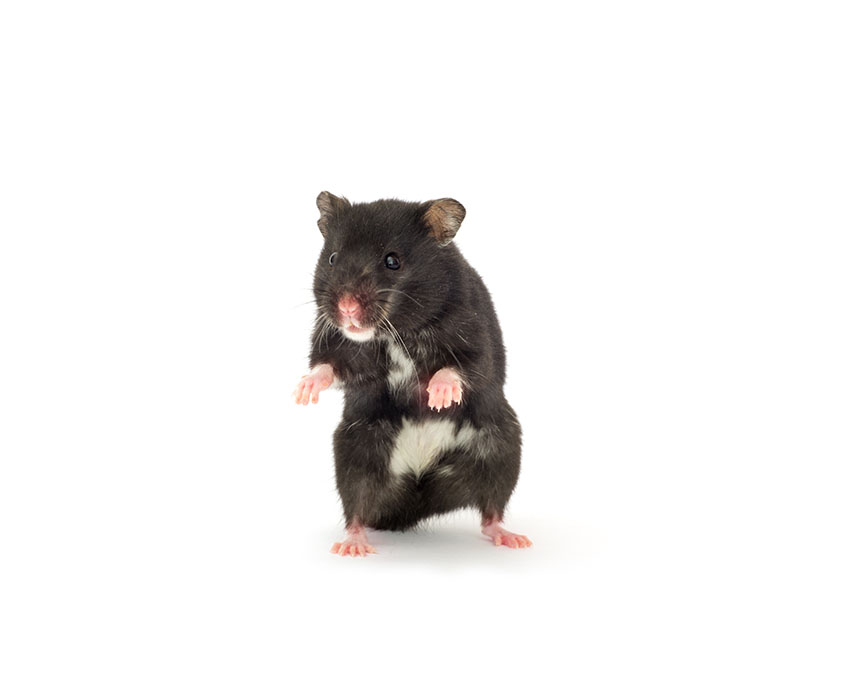
Hamsters eyes, if healthy, should be bright, shiny, and free of swelling and excess discharge
Either in or outside of its cage, your hamster can hurt itself by tripping, slipping, or cutting itself. If you’re keeping hamsters together, then you should be aware that hamsters are capable of seriously injuring one another. If a fight breaks out, these hamsters will need to be separated, sometimes permanently, and the injured hamster may require veterinary attention.
Depending on the severity of the injury, you can either treat some issues such as small cuts by dabbing them with a bit of lukewarm water, but more serious injuries it will need to be treated by a vet. If you are unsure, we advise that you be cautious, and seek advice from a vet.
Hamsters have very poor eyesight, and they can really injure themselves by falling off of things. They have very short legs which are unlikely to be able to offer any protection if your pet falls, and so even a drop of a few inches can be a problem. If your hamster falls off anything, then check that it hasn’t injured itself before placing it carefully back in its cage. Your hamster should recover itself quite quickly, but if it does not, then there may be a more serious problem that requires veterinary attention.
Hibernation
Sometimes, owners will despair that their pets have died, when in fact they are just in a very deep sleep. Hamsters may sleep like this when something in their environment changes, especially if the temperature falls. If your hamster’s body is cool, and it’s only breathing very very softly, then your hamster may be in a deep sleep which we will call ‘hibernation’.
A lot of people are under the wrong impression when it comes to hamsters and hamster hibernation. Unlike hamsters in the wild, many experts feel that hamsters that are being kept as pets should not be allowed to hibernate, and that the owner should take steps to remove their pet from this condition. If your hamster is curled up in a ball, and you can’t see any obvious signs of it breathing, then watch it very carefully - during hibernation, breathing is greatly reduced, and you may only be able to see little movements every few seconds. If you see these signs, then you might need to bring your hamster back from its hibernation-like state. You can do this by moving your hamsters’ cage into a warmer spot. It should wake up and begin moving around within an hour or so. To prevent this from happening again, you might want to permanently move your hamster’s home into a place that has fewer variations in temperature.
Lumps
Some hamsters will develop lumps throughout their lives. If you spot a lump on your pet, then check here to see if it can be explained, but bear in mind that you may need to take your pet to the veterinarian.
Mammary gland lumps - It’s a good idea to be on the lookout for mammary tumours in your female hamsters. Mammary gland tumours will be firm lumps that grow quickly, and need to be treated by a vet as soon as possible. There are some obvious scenarios in which a slight swelling of the mammary glands are normal - for example, do not be alarmed if your female hamster’s mammary glands swell a little during her pregnancy. This is just her body preparing to provide milk for her youngsters. However, if the mammary area swells, then this could be indicative of mastitis, a different problem which will require veterinary attention.
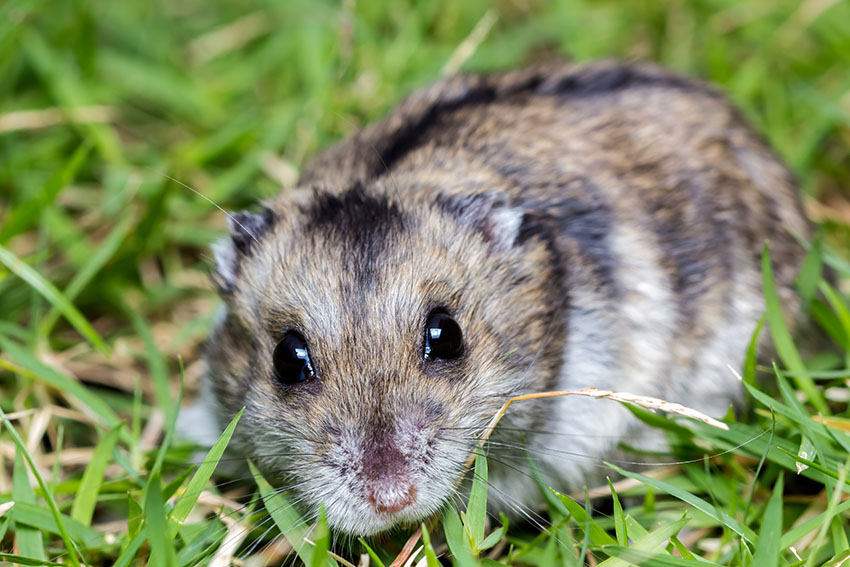
Be on the lookout for any lumps on the skin
Some species of hamster have quite prominent testicles, but owners should be wary of the possibility of testicular tumours. If your hamster’s testicles don’t retract into its body when it is cool, or if they are very firm, then your pet may have a tumour.
If the testicles are very obvious, then it may be that your hamster is too hot. If you put your hamster back in its cage and there is no change in testicle size or shape then this can be indicative of a problem.
Overgrown nails
If your hamster’s nails have grown long enough to develop a strong curve, one that is so strong that the nail is beginning to grow back towards the hamster’s foot, then you’ll probably need to trim your hamster’s nails. Human nail scissors or clippers can be used for this. Trimming will need to be performed by an adult. Probably the best technique is to only take off a tiny, tiny piece of nail at a time, as hamsters have blood vessels in their toes which are very painful if cut. Stop once the nail no longer curls. For more information on nail trimming, have a look at our ‘How To Trim My Hamster’s Nails’ section.
Parasites
Unfortunately, hamsters can get infected with a number of parasites that can cause your pets a lot of discomfort. When you’re checking your pet’s health, it’s a good idea to know some of the symptoms of parasitic infection so that you can identify these problems if your pet develops them. Below are some of the signs that your pet is suffering from a parasitic infection.
Worms - hamsters can contract a number of different worms, and a long time can go by without them showing any obvious symptoms. Be on the look-out for weight loss and diarrhoea, as these are the general warnings that your pet has been infected by an internal parasite.
Mange - sarcoptic mange is technically a type of mite, a very unpleasant one that actually burrows underneath your pet’s skin. Symptoms of sarcoptic mange include dry, scabby skin and lots of scratching. Your pet also may develop a thinning of hair and bald patches. It’s a really painful condition for your pet, so treating the condition quickly is a must. Treatment will include thoroughly cleaning the cage and purchasing Ivermectin drops from your veterinary surgery in order to help fight the mite.
Mites - mites are a very irritating and a sometimes painful condition for your pet. If your pet has very dry skin and hair loss, then it may be suffering from a mite infestation. If the existence of very flaky or crusty areas of skin is accompanied by a high level of ear wax then the problem may be ear mites. You will likely need to take your pet to the vet for a proper diagnosis.
Fleas - fleas are visible, and as on cats and dogs, cause a lot of itching. If you notice your hamster scratching itself a lot, then it might be a good idea to give your pet a health examination. If you have a good look at your hamster’s coat during your regular health check then some signs of fleas to look out for are small insects that jump and move very rapidly, and flea droppings. These will look like black dust in your hamster’s fur, but if you place them on white kitchen or toilet paper and add a drop of water, then they will become dark red, as they are mainly formed from your hamster’s blood.
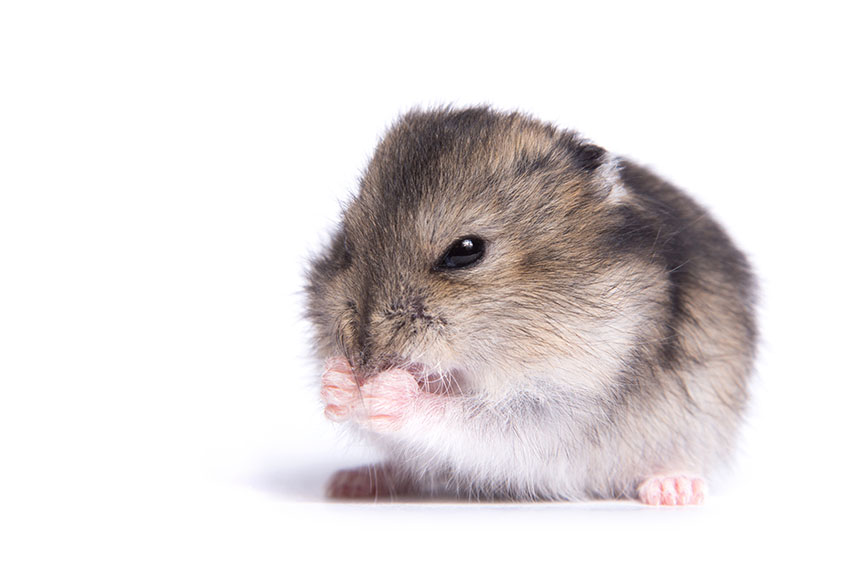
Keep a close eye on how your hamster breathes - is it struggling at all? Is it wheezing?
If your hamster is coughing, wheezing, sneezing, has a runny nose or eyes, or is having difficulty breathing, then it may be suffering from a respiratory infection. These problems need veterinary treatment as soon as possible, because they can hinder your pet’s ability to breathe. Be aware that respiratory infections share a number of symptoms with allergies.
Strokes
Like humans, hamsters can suffer from strokes. If your hamster has had a stroke, then it will look very dizzy, and may continually move back and forth, even when it’s sitting down. Strokes can have minor and major effects, but effects of even quite severe strokes can wear off with time.
Teeth
Hamsters eat a lot of very hard food, so their teeth are very important to them. If your hamster has blood around their mouth, or has stopped eating, then they may have broken one of their teeth. While holding your hamster, gently examine their teeth - has one of their teeth become a lot shorter recently? Has one of the teeth on the opposite side grown longer than it should have because there’s nothing in the way? Having a painful or missing tooth will cause problems with your hamster’s nutrition, so if you suspect tooth loss or injury, take your pet to the vet. Tooth loss is especially problematic, as it can mean that the opposite tooth will grow very long, potentially damaging your hamster’s mouth.
Other dental problems that can occur are overgrown teeth. If your hamster’s teeth have become overgrown, then they may have blood around their muzzle, chew hard objects around their cage, or stop eating. They need to have their teeth altered by a vet.
Urinary Problems
It may be a good idea to have a quick check of your hamster’s bedding when you’re cleaning them out. For example, it’s good to have a look for the presence of blood - this will have come from your pet and perhaps their urine. Watch out for your hamster’s urine changing colour drastically, without any serious changes in diet - if you notice this then a vet trip may be required.
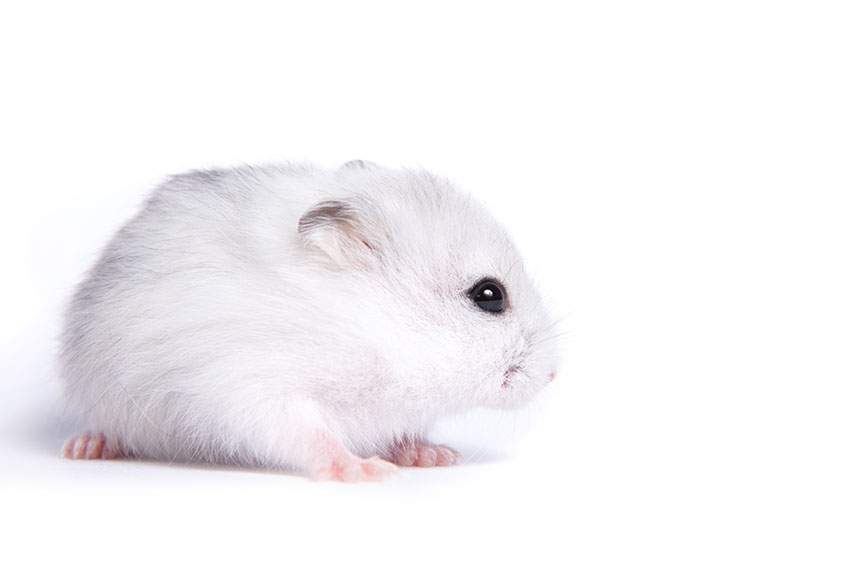
Hamsters can suffer from urinary issues
If your hamster is urinating less frequently than usual then this could be a serious problem. If you notice that your hamster has not urinated in a while, then feel its stomach - if it feels hard and bloated, then your hamster may be suffering from a bladder stone, and therefore a partial or complete blockage of their urinary system. If this occurs, you’ll need to take them to a vet as soon as possible, as these conditions can be extremely painful, and perhaps fatal, if not treated in a timely manner.
Weight Changes
A hamster’s weight can reveal a number of things about its health - if your pet is losing weight rapidly, then this can indicate conditions such as overgrown teeth, broken teeth, parasites, or respiratory infections. If you notice your pet’s weight is dropping, give it a good, thorough health check. Another common cause of weight loss is dehydration, so check both your hamster and its water bottle (see dehydration above).
If your hamster is gaining weight, then this could be indicative of things such as tumours or pregnancy. It could also indicate conditions such as bladder stones. As with weight loss, give your pet a thorough health check.
Wet Tail
Wet tail is a potentially fatal condition for hamsters, and so action needs to be taken very quickly. Wet tail is a very serious case of diarrhoea, one which is so severe it often causes death within two or three days. If your hamster has a wet tail-area (possibly with lots of faecal matter around it) and has a strange posture, then it’s likely suffering from wet tail, a really painful condition often caused by bacteria.
If you think that your hamster has wet tail, then the first thing to do is to take it away from your other hamsters. This is because the condition can spread rapidly, and bacteria can linger in enclosures. The second thing to do is to try to provide as much moisture as possible in order to help rehydrate your pet. Next, get your pet to the vet as quickly as possible. Your veterinarian may be able to prescribe some antibiotics to help your pet fight the infection, and they may be able to take some emergency measures to help your pet rehydrate.

Comments
Edwina, 20 March 2024
I recently rescued a hamster. He is really wobbly when he walks and sits still. The cage he was in was the one where the bottom is a small tank and the top is the wired house shaped thing. He only had a water bottle, food dish, one chew toy, one small hide that was to small for him to fit in, and at most two inches of bedding. He was fed really low quality food, and the previous owner would take his water away because she thought "he drank to much water." I did some research and for what I've read it can be malnutrition, lake of exercise, or a stroke. I'm really worried about him. I have him in a big cage with lots of enrichment and a 10.2 inch wheel. His back is fully straight, but he is barely going any faster than a walking pase. It could be because it's his first time using a wheel. I'm not sure. What do you think I should do? Also he is a Syrian on the small side.
Irene, 12 April 2023
Our hamster has lost half of its hair worse though it has a very strong odor of urine constantly in the cage, it's eating ok and drinking watet
Leah, 6 June 2022
My hamster has a swollen nose, more to one side of her face than the other and her eye is weepy on that side as well. I recently had a cold and am wondering if I gave it to her. She's also making little noises sometimes. What can I do???
Taylor, 24 January 2022
My hamster has a tiny little bump under his eye it almost looks like a pimple I just noticed it today what should I do will it go away on its own?
An Omleteer, 28 December 2021
My first hamster has wet tail and keep sneezing, he was always have wet hair and he started to weaken and he died. my hamster that lives with the first one was has a wet tail again within one week, i was scared that she might die, what should i do?